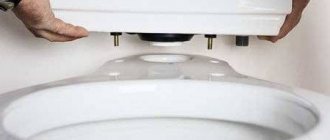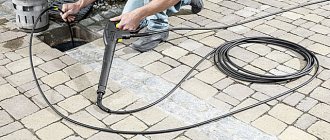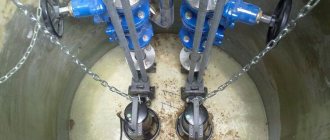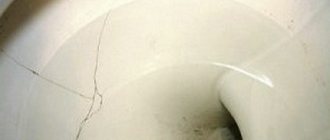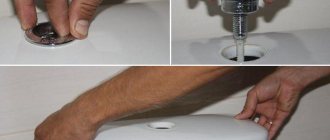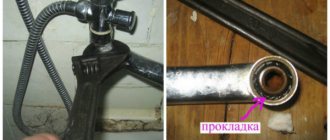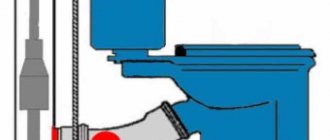How to use the toilet if you put a stopper for debts
The toilet can be used if the drainage service is partially interrupted, when a coarse mesh is installed instead of a blind plug. Theoretically, feces can be washed away with large amounts of hot water, in which they gradually dissolve by pushing them down the drain with a plunger. Once a blind modification has been installed, and various methods of removing the plugs have not been used or have not brought a positive result, there can be no talk of using the toilet and sewerage system.
The debtor user can negotiate with neighbors, visit bathrooms at work, in the building of housing and communal services or management company, at public catering establishments (McDonald's), in places of cultural recreation (cinemas, theaters, cafes, bars), dry toilets on the streets or construction sites, paid establishments. In emergency situations, green spaces or high snowdrifts in winter, located near the debtor’s place of residence, can help out.
Rice. 12 Installing and removing plugs from the sewer using manipulators
Alternative option
If the toilet is securely fixed to the floor or removing the plug from the sewer is impossible, but there is an inspection hatch, it makes sense to work through it. In this case, you need to be careful, because waste or hot water may pour from above; do not neglect protection. It's simple:
- First, the inspection window or hatch opens.
- You need to have a harpoon or a long stick with a hook, which will need to be used to pick up the plug. There is a possibility that the tool will slip out of your hands and fall down, making it impossible to get it out. Therefore, it is worth tying a rope to the end and leaving it outside so that you can intercept it if something happens.
- Carefully pry up the plug and remove it. You need to act very carefully so that it does not fall and block the riser.
After completion of the work, the hatch must be closed and the plumbing installed in place.
They put a plug on the sewer, what should I do?
Consumers who find themselves in a situation with a blocked sewer outlet have several ways to solve the problem; they can be roughly divided into legal and illegal. The measures taken by the consumer debtor consist of the following actions:
- Full payment of the rent debt, in this case the contractor must remove the plug within 2 days.
- Usually, a person who finds himself in a difficult life situation can always come to an agreement with the management organization in the form of a written agreement with the executor on debt restructuring. In this case, an agreement is concluded between the parties with phased monthly payment of the resulting debt, although for the last month the rent will have to be paid in full.
- Since, in the opinion of many human rights activists, this method of dealing with defaulters is a humiliation of human dignity and even equates to torture, if the consumer-debtor has valid reasons for not paying rent on time, you can file a claim with the European Court of Human Rights ECHR after going through all legal proceedings authorities of the Russian Federation.
It is clear that citizens with such capabilities are unlikely to find themselves in the situation of rent debtors, because filing a claim will require the services of expensive lawyers. In addition, the cost of the issue is not too high and the application is likely to be rejected for consideration.
- The reason for appealing to the Russian courts may be a violation of user rights when installing a blind sewer plug. Since, according to the law, the contractor does not have the right to turn off cold water to debtors, and the use of a plug actually leads to its shutoff due to the impossibility of draining, there is some probability of obtaining a decision in the courts to cancel the installation. It is clear that suing the state housing maintenance service from the same branch with the court is problematic, however, if the management company is a private structure, the chances of winning the case increase.
- Another legal clue for appealing to the courts is blocking the sewer system for a defaulter in a communal apartment with several owners who do not have rent arrears. A similar situation is if tenants live in the same apartment with separate settlement accounts for rent and one of the parties has no utility debts.
- You can turn to “black” plumbers who have equipment for installing and removing plugs, but this will require free access to the roof through a closed technical floor, and the cost of the service can be quite significant.
- If a consumer-debtor has been given a plug, he has already “got” money in the amount of about 10,000 rubles, which will be forcibly deducted from him for installing and dismantling the device. There is no doubt that this amount also includes the price of the plug itself, the cost of which is not too high and it cannot always be reused.
Rice. 7 Installation of plugs on the toilet - diagram
Methods for removing plugs
You need to immediately understand the following point: pneumatic plugs for sewage systems cannot be removed with chemicals. The reason is simple: the same materials from which the pipes are made are used to make the plugs, therefore, when the obstacle is destroyed, the system is also destroyed - and its repair can cost much more than paying off the debts.
Thus, the most affordable method of removing the plug is to use mechanical methods. This is the most correct answer to the question of how to remove a plug from a sewer. Naturally, the plug stays in the pipe more firmly than a floor rag that gets there, but sufficient effort should be enough. So, the first and most accessible method involves removing sewer plugs for debtors with a plunger.
How does this happen:
- Before you remove the plug from the sewer yourself, you need to understand where the plug is located. To do this, it will be enough to tap the pipeline: in filled places the sound will be dull, and in empty places it will be ringing.
- If the sewer system was not used after installing the plug, then you need to find a plumbing fixture located as close as possible to the main line.
- Now you need to run water in this device and wait until it reaches the drain grate.
- The plunger is installed above the grate, after which it must be pumped several times to create increased pressure in the system. Water is not compressible, so the pressure will cause it to act on the plug, forcing it out of the system.
If the plunger does not help, then you can use a plumbing cable, which is also a good way to remove the plug on the sewer pipe. More information about using a plumbing cable can be found in articles dedicated to this device. In short, a plumbing cable will allow you to remove the plug and push it out, resulting in the drain being cleared. As a last resort, if all else fails, you can dismantle part of the sewer and get to the right place. Sometimes even this method allows you to eliminate the problem without any problems.
The fight between defaulters and utility companies has been going on for quite some time, and both sides are constantly coming up with new methods to fight each other. The plug on the sewer pipe is installed using high technology, but residents respond no less inventively. Be that as it may, it is always much better to pay all bills on time and sleep peacefully.
https://kanalizaciyadoma.com
How to remove the plug
If it happens that the pipe is blocked, there are several ways to remove the plug from the sewer:
Pay the bills.
It is understood that such a measure should motivate the owner of the premises to deal with debts. In this case, the management company itself will remove all obstacles to the sewer water. This is the most obvious and logical way, but it is not suitable for everyone.
Contact the professionals.
Not all plumbers like to take on calls to remove plugs. This is labor-intensive work, because simple overlays are installed less and less often, and you have to spend a lot of time and effort to remove them. In addition, obstructing a court decision is an unpleasant matter, and not everyone is ready to deal with it. But there are such companies that are ready to remove the installed plug from the sewer, and there are quite a few of them.
Remove the plug yourself.
Of course, this will require even more time than in the case of a professional plumber. It is important to understand how modern plugs are designed, the principle of their fastening and the procedure for dismantling, so as not to damage your own communications or, more importantly, the main riser, because this will lead to intervention by the management company.
Description of the blocking element
There are enough defaulters, so utility services find ways to stop the water supply to a certain apartment - it simply turns off. Sewer plugs for debtors are the easiest and most affordable way. In the case of apartment buildings, there is a certain complexity, since there water is supplied through one riser, which is only completely shut off.
Of course, plumbing valves are also installed inside apartments, but every citizen has the right not to allow controllers into their home. The companies have developed an interesting solution: if it is not possible to shut off the water to the apartment, then a plug is used on the sewer pipe.
Depending on the purpose of the valves, they come in the following types:
- Solid - completely block the movement of wastewater.
- Lattice - allows liquid to pass through, but not solid waste, which accumulates over time.
A plug for non-payers is a legal solution, since the company continues to need to service the apartment without entering it. The result does not take long to wait, since wastewater already becomes a headache for the defaulter within one day (on average, about 200 liters of waste are generated within a day).
Removing traffic jams
A logical question arises here: what is so difficult about this work?
In fact, there are a lot of nuances.
Firstly, you may have a sewer plug Sprut, which is usually installed due to debt. Its essence is simple - using special equipment, a plug is inserted into the hole in your outlet from the riser, which blocks 97% of the liquid from draining.
Operating principle of the Sprut system
The problem is that dismantling such a barrier may result in fines from the relevant services (although here you still need to prove the legality of the sewer plug for debtors). But even if you close your eyes to the legal aspects of the issue, another difficulty appears - if the plug is simply knocked out, it can get stuck in the riser, and this will block the drainage of water on all floors.
Utility inspectors
Therefore, it is better not to take risks, but to use this method: take a drill, a drill bit and bore the element along the edges, and then carefully remove it.
Secondly, if the riser is cast iron and the plug is old, then it may simply not be possible to dismantle it. In most cases, they begin to attack the product with a hammer, and this can lead to the destruction of the entire pipe - cast iron is a brittle metal.
And here, too, you can try using a power tool - make small pinpoint cuts with a grinder and break off the metal in small pieces. Such work will progress slowly, but the likelihood of deformation of the entire riser as a whole will be low.
Example of a cast iron sewer pipe with a plug removed
This concludes our review and now we will summarize its results.
How to remove a plug from a sewer
We warn you right away that the plug can be removed legally only after the utility debt has been paid. In this case, specialists will arrive in the shortest possible time and remove the silencing agents from the apartments.
As soon as the plug has been put in place, most debtors realize that their debt is not that big and quickly run to pay it. This is understandable, because it turns out that living in spartan conditions, without a toilet at home, is very uncomfortable. Not to mention the fact that I want to take a shower, at least occasionally. So the topic of removing the plug is more than relevant for everyone who is behind on utility bills.
The maximum period for restoration of services that you have the right to demand after the debt is repaid is two days. During this time, the company servicing your home must remove the means blocking the apartment’s access to the sewer system. If it is not yet possible to pay the entire debt in full, its payment is divided into months and the stub is also removed.
But for this to happen, you need to write an application for the resumption of services and send it to the RSO or management company. Each party must have a copy of the application, so write two documents. In addition, neither utility companies nor any other services that remove the stopper have the right to demand payment from the debtor for services to remove the stopper.
But this is only if we are talking about a legal procedure, but there are cases when the plug is removed illegally, that is, without paying off the debt. This procedure is usually carried out by amateurs, who can severely damage the system, making restoration of drainage functions impossible without expensive repairs.
Here is a list of ways you can remove the plug yourself:
- Dismantling the toilet. This option will be effective if the toilet is fixed to the floor and not filled with cement as in old systems. So, having turned off the water and disconnected the plumbing, you need to find out how far away the plug is. Next, you need to try to grab her and drag her into the apartment. Under no circumstances try to push the plug into the drainage system, otherwise you will block the sewer system for the entire house, for which no one will thank you.
- Chemical attack. In this case, we do not remove the plug using the standard mechanical method, but remove it using chemicals. Of course, this is not as fast, but there is less chance that the system will become clogged with a plug. It will simply be eaten away. Just first, find out which plug is on the system, otherwise there is a risk that the funds will not cope even in the week that is given to carry out such work.
Work order
Non-paying residents, who do not want to be left without amenities and overpay plumbers, are trying to remove the plug themselves. In order for your attempts to be successful, you need to act in stages and have a clear idea of how to remove the plug from the sewer yourself.
- Assess the situation. Study where the plug is installed and how best to get to it. Most often it is installed on a pipe coming from the toilet, so it will have to be dismantled. This is not difficult with modern models, but if the toilet was installed a long time ago, problems may arise. Often the plumbing is concreted, and as a result, the floor will have to be dismantled. This is fraught not only with additional labor intensity, but also with unexpected costs.
- If the plumbing is new, this makes the task much easier. First you need to turn off the water and drain it from the tank, then carefully disconnect it. Then you should remove the toilet mounts and move it away. When working with the key, it is important to be careful not to damage the plumbing.
- Shine a flashlight into the pipe to find out how far away the plug is. If it is rubber, you can pry it with a hook and pull it out easily. With lattice it will be a little more difficult. To remove it you will need pliers if the plug is close, or something long, a stick with a hook or a harpoon. It may be necessary to push the grille forward a little at first, but you need to do everything carefully, and be sure to carefully remove the plug from the pipe. The simplest option seems to be to knock it inside, but with a high degree of probability it will stand across the main riser, causing a blockage. It will, of course, be quickly eliminated, but the management company will find the reason and install a new plug.
First way
Second way
The procedure for installing and removing a sewer plug
Almost all multi-storey buildings have a central riser that runs through all floors and ends in a vent pipe on the roof, which is necessary for ventilation and air access to the duct. Therefore, theoretically and practically, installing a plug through a pipeline from the roof to any apartment does not present any particular difficulties; operations are carried out in the following sequence:
- Using a special camera and lighting, the condition of the sewer riser (the surface of the inner shells of the pipes) in the overlap area is studied, and based on this, the type of plug is determined. At the same time, the material of manufacture of the riser is also taken into account - different types of plugs are installed on smooth polyvinyl chloride (PVC) plastic and cast iron pipes rough on the inside.
- Next, they begin to immerse the plug, models with sharp teeth are lowered into a PVC plastic pipe for fixation on smooth walls, and self-expanding structures are placed in cast iron risers.
- After the user pays the rent in full, representatives of the installation company return to the roof and lower the manipulator into the sewer shaft. An operator-controlled device compresses the sliding structure or releases air from the ball, after which it removes the plug to the surface.
Rice. 8 Placement of cylindrical plugs in the sewer tee
Making and installing a plug yourself
Let's look at the simplest way to make a flange plug from a plastic cup. This item is in every home, and the plumbing store may be closed or located tens of kilometers away.
Required materials and tools
- roulette;
- hacksaw for metal;
- glue gun;
- cord;
- scissors;
- piece of car tire;
- Silicone Grease.
Installation features
The main task is to strengthen the walls of the glass and bring them into line with the outer diameter of the pipe. To do this, use a cord glued to the pipe using a heat gun. The winding is carried out until the cup fits tightly onto the tap. After this, the outer walls of the glass are strengthened in a similar way.
Installation steps
Installation of a homemade plug is carried out in the following sequence:
- Cutting the gasket to the shape of the bottom of the glass.
- Lubricate the outlet with silicone grease.
- Installing a plug on a pipe.
- Fixing the assembled unit with insulating tape.
- Finally, the plug is checked by running water through the sewer.
Is it legal to install sewer plugs for debtors?
To answer the question of whether a management organization is authorized to install a sewer plug for debtors for non-payment, one should consider the fundamental document, which is Government Decree of the Russian Federation No. 354. The main provisions for the actions of public utilities in relation to debtors are indicated in paragraph XI, paragraphs 114 - 119, their contents are as follows:
1. In case of utility debts from residents, the contractor is obliged to seal electrical panels, plumbing fixtures and other equipment both inside and outside the apartment of the debtor consumer.
2. Regardless of the presence or absence of an agreement with the resource supplying organization from whose networks the debtor is cut off, disconnection operations are carried out by an organization engaged in the maintenance of utilities at home.
3. To carry out the work, a court decision is not required; the basis is an application from the organization supplying the resource or providing services.
4. If the rent is not paid in full, the contractor is obliged to knowingly notify the defaulter before limiting or stopping the provision of services. By incomplete payment we mean an amount higher than 2 months’ payment for one utility service.
5. In case of partial payment of rent, the entire amount is divided between services and expenses for technical operation, deductions for major repairs in proportion to their size. It should be noted that this clause excludes the legal loophole that the debtor could take advantage of by paying the minimum amount of rent with a statement that he only pays sewerage services with the expectation that a plug will not be installed.
Rice. 5 Mesh plug for sewerage for debtors
6. The period before which the executor cannot impose sanctions is limited to two months; after its expiration, the debtor is sent a warning with a requirement to pay the debt within 20 days. If the debt is not paid, a restriction on the provision of the service is introduced with the presentation of an appropriate notice, and after 10 days it is suspended.
Many people are interested in the question of whether they should pay for the installation of sewer plugs; the answer to this is given in paragraph 121(1) of Section XI of Resolution No. 354.
It is clear that no one will be able to avoid the unreasonably high payment for the services of third-party organizations (from 6,000 to 10,000 rubles), which the performer may hire in a criminal conspiracy - the costs will be included in the allowance for the rent and collected forcibly.
Rice. 6 Special equipment that helps install plugs
Installation mechanism and whether it can be removed
The easiest way to solve the problem is to pay off your debts. Liquidation of debt will lead to the removal of the silencing device by the management company. Technically, it is very difficult to remove it, since it is installed using special equipment. For this purpose, a probe and a manipulator are used. The sewer plug is equipped with a camera, which allows it to be placed exactly in the place where it is really needed.
Many devices have been invented, but they are all approximately the same in their principle of operation. The manipulator is lowered on a long cable.
Structurally, a plug for a sewer drain pipe can be presented in various forms, as well as the material for its manufacture. It is made of metal and polypropylene. Mostly, they use the second option.
Utilities use the following types:
- Solid type. When installed, the movement of wastewater through the sewer riser is completely stopped.
Solid closing lid
- Lattice type plug. The liquid passes unhindered, but the suspensions are retained, which causes their gradual accumulation.
- Pneumatic plug. A device in the form of a rubber inflatable ball.
Rubber-cord pneumatic plugs
It is not difficult to imagine what an unpleasant odor this will create in the apartment. After all, a large amount of liquid waste is removed from the apartment every day.
The plug is installed as follows:
- First, a specialist from the management company studies in detail the diagram that was used to connect the sewerage system. This is necessary because the apartment may have several sewer risers. Installing just one partition is unlikely to create serious problems for the resident.
- After studying, an action plan is developed for how the plug will be installed. The point of its installation is outlined. Usually this is a section of the sewer network that limits the toilet from the riser.
- It is necessary to select a place for convenient control of the equipment. Usually this is the roof.
- A device consisting of a manipulator, a light guide and a camera is lowered into this pipe. The plug is brought to a specific location and installed.
After installing the plug, the drains stop flowing only in a separate apartment. The sewerage system of neighboring apartments will continue to operate as normal.
Restrictive measures for debtors
It is, of course, possible to remove the plug, but this requires some experience working with sanitary devices. Otherwise, inept actions will lead to the riser becoming completely clogged, and in the worst case scenario, damaged and malfunctioning.
It is very problematic to classify such work as a pure category, since, for example, it will be necessary to remove the toilet. How the barrier device will be removed depends on the presence or absence of a sewer inspection window in the apartment, as well as on how the sewer system is connected. It is much easier to carry out such activities if risers made of plastic or metal-plastic are installed. It is more difficult if there is a cast iron riser.
They are removed using mechanical or chemical methods. With any of them, there is a high risk that the riser will become clogged.
We disconnect the toilet and partially disassemble the riser
You can remove the supplied plug from the sewer yourself by partially disassembling the problem area. This method is applicable for recent toilet installations. It must be secured to the floor with bolts. You should not even try to disassemble the toilet if it has been installed for a long time and is filled with cement. If you remove the toilet, it can be deformed.
The plug is usually placed where the sewer enters the living space. Access to this location is required. Therefore, the toilet is initially removed. If the toilet is of a modern design, then removing it is easy. But first, they turn off the water supply by turning it off with a tap. First remove the drain tank. Then the bell is disconnected. Next, the toilet itself is removed.
Removing the plug after removing the toilet
You need to unscrew the bolts that secure it to the floor.
When the device is completely removed, access to the partition is gained. Now you should remove the plug from the sewer pipe and carefully remove it. This stage is important; errors must be excluded. Some try to push it inside the boner. There is no need to do this under any circumstances. The plug will fall into the common riser and block it. In this case, all residents whose drainage is connected to this riser will no longer be able to use the sewerage system.
You must try to pull the plug into the apartment. How to do this will depend on how long the pipe is. You can use pliers. But perhaps the length will be longer. Then you need to make a metal hook or use a regular fishing harpoon. It is quite possible to grab it, since there are holes in it.
When you manage to hook it, you need to carefully pull the plug inside the apartment. Maximum care is required when carrying out such work. The device must not be allowed to end up inside a sewer riser. When the plug is successfully removed, work is done to install the toilet and return it to its original place. All steps are performed in reverse order.
Removing the limiter by a master
Of course, you will need a whole set of tools. Without them, the plug simply cannot be pulled out. If such tools are not available and you do not have the skills to work with plumbing devices, it is better not to remove the barrier device yourself. The arsenal of tools must include wrenches in the set. You can't do without a hammer and an adjustable wrench. Additionally, you should stock up on a flashlight, a hard hook or a harpoon.
Chemical removal using revision
By the way, using this method does not provide any guarantee that the stub can be removed. Sometimes, if the riser connection configuration allows, you can achieve a completely positive result.
When the toilet is filled with cement, you shouldn’t even try to remove it. However, the apartment may have an inspection of the sewer riser. Then it is quite possible to extract it through this window. First you need to stock up on a long thin stick with a metal hook at the end. You can also use a fishing harpoon for this. The stick may slip out of your hands and fly inside the riser. Then it will be impossible to extract it from there. To prevent this from happening, you need to tie a rope to the stick. If it accidentally slips out, it can be pulled out.
The actions are simple to perform. First remove the inspection window cover. The hook or harpoon that was prepared in advance should be inserted into it. After this you need to try to hook it. If this is successful, it is carefully pulled into the riser, and then it is taken out.
Removing a stub using revision
In the case of a polypropylene or mesh plug, performing similar actions is easy. However, this method is associated with a number of disadvantages:
- Before carrying out such actions, it is necessary to prepare and wear appropriate protective clothing. You should take care of protective measures, because at this moment anything can be dumped into the sewer from above, including boiling water.
- There is a very high risk that during such work the plug will fall out and end up in the general sewer riser. Then it will block it completely or partially.
- A significant drawback is that all work is performed almost blindly. True, it is not difficult to determine the location of the fencing device. At the moment when the metal hook touches the walls of the riser and the surface of the plug, the sound will be different in nature.
You can try to dissolve the grate. To do this, you can use the drug "Mole". It contains oxalic acid. This option is applicable only if the utility company used a non-metallic plug. You should not count on quick results. This will take at least a week. Some time will pass, the grate will dissolve and the plug will disappear.
Mole is a powerful chemical for removing contaminants and obstructions in the sewer system.
Citizens who have removed the partition often use an anti-plug so as not to fall under restrictive measures again.
Step-by-step removal of a sewer plug
Before you remove the plug, please note that there are many things to consider when it comes to different homes and plumbing fixtures. This instruction manual is intended to provide a basic understanding of how to remove a debtor drain plug and may not cover all circumstances
One important thing to know before attempting any project in your home is the access points to your plumbing. You may find yourself unexpectedly needing access to your plumbing system. Keep in mind that trying to remove a drain plug may be opening a can of worms, and you need to be prepared if the removal process suddenly gets out of hand. Plugs are installed at various points along the sewer line. Their purpose is to provide access inside the pipe so that blockages can be more easily removed by inserting a hose through the opening for cleaning purposes or to punish residents who have not paid their utility bills. They also help keep noxious odors and hazardous sewer gases from escaping, pests, and waste back up.
The cap is usually made from the same plastic material as the rest of the pipe—or PVC—and the cap is screwed on for easy access. Although they can sometimes become sealed, removing a drain plug is a simple process that does not require much time.
After which it is important to install the new part in place. To determine where the plug is located, you will need to remove the toilet and disconnect the flare to the first connection
Can I remove the plug myself?
The situation is far from hopeless and there is always a solution. It is quite possible to remove the plug from the sewer with your own hands, but you will have to try. Unfortunately, actions such as dismantling the toilet cannot be avoided. It's better to get to work before it gets filled with sewage.
There are two ways to deal with such constipation - mechanical and chemical, but you need to take into account that incorrect actions can cause clogging of the riser. Let's look at the existing options:
- Using a regular plunger. By lightly tapping, you should determine where the plug is located, then fill the toilet or sink with water, and then use a plunger. The plug will just pop out.
- A plumbing cable will allow you to remove the installed plug. You will have to insert the cable into the riser where the plug is located and pull it out with a twisting motion.
- Manual method. You will need to dismantle the toilet and pull the valve out of the drain through the hole. You can use chemical elements, but you need to make sure that they will not damage the pipe.
To understand how to dismantle the plug yourself, you will also have to study the general connection diagram before you begin any manipulations. If the apartment has a plastic riser, then solving the problem will be less complicated.
Legality of installation
Do they have the right to put a cap on a sewer pipe if the owner of the residential premises does not pay for utilities? Are the actions of management companies legal? To answer this question, you need to familiarize yourself with the current legislation, namely:
- Federal Law No. 416;
- Government Decree No. 354;
- Government Decree No. 47;
- SanPiN 2.1.2.2645-10.
In accordance with SanPiN and Resolution No. 47, all residential premises must comply with safety standards, including in the case of sanitary requirements. The lack of sewerage in the premises can lead to the impossibility of comfortable living and violation of sanitary standards.
However, according to the Law “On Water Supply and Sanitation” (Federal Law No. 416) and PP No. 354, organizations providing water supply and sanitation services have the right to limit the provision of services in the event of lack of payment for 2 months or more.
In accordance with the disagreements that arose, the issue of the possibility of installing plugs for non-payment was resolved in the Arbitration Court. The court decision states that management companies have the right to limit water drainage in the debtor’s apartment, but only in accordance with the rules and safety standards. That is, at present, installing plugs for debtors is a legal procedure.
Legal grounds
In search of a solution to the problem with non-payers, management companies considered different options. Finding an acceptable way is not so easy: the owner of the apartment has not only responsibilities, but also a number of rights that must be ensured to him.
Blocking the water supply for non-payment seems the most obvious option. But this violates the sanitary requirements that apply to housing. Water is supplied through a common riser; it is impossible to shut it off from the outside without depriving all users of water supply. And the human right to the inviolability of one’s home allows one not to allow inspectors into the apartment and to manipulate one’s property.
Then the practice of suspending water disposal appeared. It should be noted that such a decision is often made not by the management company itself, but by the court, and is completely legal. But there is a nuance.
The management company is obliged to notify in advance of the decision to stop the provision of sewerage services. This must be done against the signature of the apartment owner or by registered mail with notification. If a plug was installed on a sewer pipe without the owner's knowledge, this could cause problems for the company. Of course, the debtor will not be able to write off the debt, but he can demand compensation for moral damage and inconvenience through the court, and the claim will most likely be satisfied. If the management company does not have a signed receipt, it is easy to prove ignorance to the owner.
Stub Example
How to install the valve
Sewerage is closed as a last resort, when the resident has been repeatedly warned and utility services have been suspended.
Before covering it is necessary:
- check the condition of the pipes;
- notify the debtor of the upcoming sewerage closure;
- provide a safe exit to the drain pipe;
- make sure there are no branches at the riser.
The debtor is notified by the housing and communal services services by sending him the appropriate paper, which must contain information about the restriction or suspension of wastewater disposal services if he does not repay the debt within 1 month after receiving this notification. It is handed over personally to the defaulter, who must sign upon receipt, or sent by registered mail.
If the debt is not repaid within the allotted time, the management company employees begin installing the plug:
- A specialist studies the layout of the sewer system to determine the number of drains that need to be blocked. If there are several drains, then valves are installed on all of them. When only one is blocked, residents can use the free ones.
- Select the type of plug and its installation location. In most cases, the installation location for the ceiling is the main riser, which runs from the general sewer system to the toilet.
- At the final stage, a camera, LEDs or a manipulator are placed in the sewer pipe. They are controlled by the operator, who installs the plug in the selected area.
After these actions, the removal of wastewater from the apartment will be partially or completely disrupted. If a valve has been installed, then the best option for the defaulter will be to pay the debt.
Remove the plug from the sewer.
Types of plugs
When installing a plug through a riser on the roof, it is important to determine the location of the debtor’s apartment and bring it to the sewer outlet pipe. To do this, the device is lowered on a cable using a special manipulator, using a video review from the camera to monitor the installation process
Upon reaching a given point, the manipulator activates the plug, while it changes its shape and blocks the inlet to the riser, after which the installation apparatus is removed from the riser pipeline to the surface. All plugs for sewer pipes can be divided into two main types: cylindrical and pneumatic.
Cylindrical
A cylindrical type sewer plug consists of one or more metal plates placed vertically in a partial circle. After lowering into the riser, the manipulator moves the fragments apart, or rather releases the plates from compression; they, due to a spring mechanism, expand and tightly cover any side holes in the riser. The device covers the side walls, and not the channel itself, so there are no problems with other residents higher up the riser.
Some semicircular varieties have teeth on the side edges; due to the elasticity of the material when compressed by a manipulator, they initially have a smaller diameter than the internal size of the riser pipeline. After lowering the riser to a given point, the manipulator releases the plug, it straightens and is held in the pipeline by the end gear plates.
In addition to metal, a cylindrical sewer plug is often made of plastic (polypropylene); its transparent modifications, with a rubber surface or an armored anti-vandal design, are usually used.
One of the varieties of plugs of this type is a device with a mesh on a rigid frame (holes in the plate) instead of a solid valve; its installation is no different from other models, but allows the debtor to use cold and hot water.
The pipe plugs supplied to the market and the corresponding installation devices are represented by a wide range of models; their brands with the names Terminator, Cockroach, Octopus, Grotto, Whale, Onyx have different designs.
Rice. 3 Sewer plug for cylindrical type debtors
Pneumatic
A pneumatic type sewer pipe plug is a durable ball made of plastic materials (rubber) with needle-shaped protrusions on the outer shell. It is loaded into the riser using a manipulator and pushed into the side sewer outlet. After placement, the compressor supplies air to the ball, it increases in volume and closes the side pipe.
Rice. 4 Pneumatic types of sewer plugs
Removing a stub
How to remove the plug yourself and is it possible to do this? The easiest and most legal way to get rid of a blocking device is to pay the debt and provide the relevant documents to the management company. Based on consumer reviews, it takes from several hours to 1 day to remove the plug after payment.
How to remove it yourself if you don’t pay off the debt? There are several methods you can use:
- mechanical. The essence of the method is to partially dismantle the sewer system in the room by dismantling the toilet or other types of plumbing equipment, as well as the pipes adjacent to the blocking device. This method is costly in terms of time and financial investments required to purchase new pipes, gaskets and other fittings for the sewer network;
Removing the limiter mechanically
Destruction of the plug by mechanical force from the apartment is prohibited, since the remains of the equipment can block the sewer riser and cut off water drainage to other residents.
- chemical method. If a metal plug is installed, then it can be exposed to chemicals intended for cleaning pipes, for example, “Mole”. This method is less expensive in terms of money, but longer, since it takes about 1 month for complete destruction.
Pipe cleaners
How else can you remove the plug yourself, watch the video.
What to do if it is not possible to destroy the limiter by chemical means, and mechanical action is unacceptable for some reason? You can remove the plug without paying the utility debt with the help of private organizations that provide plumbing services.
As a rule, such companies have special equipment for removing restrictors, which allows the work to be completed quickly and without partially disassembling the system. However, the cost of such a service, depending on the region of the Russian Federation, varies from 1,000 – 2,500 rubles.
Methods of dealing with stubs are presented for informational purposes to show that they are quite costly in terms of financial losses and time, which are easier to spend, if not on repayment, then on debt restructuring.
How to prevent installation of a plug
By law, before limiting the provision of any utility services to the debtor, the management company must send a written notice and provide a month to repay the debts. If this is not possible for some reason, there is time to take preventative measures.
These include an anti-plug for the sewer. This is a service that some companies provide. Often it comes in conjunction with removing the plug. That is, the master first removes the obstacle, and then prevents its re-installation.
You can also make an improvised plug. The most common option is to create an obstacle in the way of the equipment. To do this, a long bolt is drilled into the sewer riser and filled with sealant to prevent waste from leaking into the apartment.
It is important to remember that the sewer riser is a common property, the damage of which is illegal. The management company has the right to later recover the costs of its restoration through the court.
What is a sewer plug
Given the number of defaulters and their rights, many utility companies have to get very creative to get people to pay. Of course, the simplest and most affordable method of turning off a tenant who does not pay for water is to turn it off in this apartment. The problem is that in apartment buildings, water is supplied through a single riser, which can only be shut off entirely - and this will immediately lead to outrage from conscientious citizens.
You can shut off the water supply to one apartment from the inside, but anyone can refuse to allow inspectors into their home, and they will be absolutely right: the current law stipulates this point, saying that housing is inviolable.
The solution that the companies have developed is extremely simple: if it is impossible to shut off the water in one apartment, then in this apartment you can block the sewerage system by simply installing a plug. Since such a solution is completely legal, it is not surprising that it is actively used.
Plugs can be very different, depending on their purpose:
- solid: such a plug on the sewer pipe will completely stop the movement of waste;
- lattice: liquid will pass freely further, but solid waste will remain at the level and will gradually accumulate.
The result is a very unpleasant result: one resident produces about two hundred liters of waste per day. Of course, such a volume will very quickly be enough to get from the remaining part of the riser to the apartment itself. Typically, installing a plug on a sewer pipe results in bills being paid within a couple of days.
Types of plugs that can be installed in the sewer
Countering defaulters is aimed at quickly collecting the debt, so the sewerage restriction must be reliable. Today, controllers use two types of stubs, namely:
- continuous - ensures complete cessation of sewage movement;
- lattice - solid elements will remain level, gradually forming a blockage, and the liquid will drain.
In any case, the owner of the apartment and its residents will experience serious inconvenience. The restriction will remain in effect until the debtor makes payment.
Useful tips
If a management organization practices installing sewer plugs in the apartments of debtor users, one of the useful tips is to prevent such a situation. In addition to the significant inconvenience of living without a sewer system, the amount of debt for utilities will increase even more due to the cost of installing a shutter device.
If you choose the lesser of two evils, it is better to allow the contractor’s workers into the apartment and allow them to put a plug on the hot water; without it you can live much more comfortably than without sewerage.
The only problem that may arise for residents of the lower floors is the possibility of installing a plug from below using rods; in this case, you will have to drill the pipe and install a pin (screw in a bolt) at the level of the inlet sewer pipe into the riser and the plug will not be able to be installed on either side.
Is shutting off sewerage legal?
The topic of whether it is legal to shut off sewerage services due to debt is quite relevant, since it does not have a clear definition of what is good and what is bad. Of course, the debtor must understand that in any case he will not go unpunished, so it is advisable to collect the amount right now to pay off the debt.
But sometimes residents can go the other way, hiring lawyers and lawyers who will find arguments in favor of the fact that disconnection for non-payment of sewerage is an illegal and even dangerous procedure. In some ways they are right, but let's look at these arguments:
According to the forty-seventh decree regarding the standard of habitability, installing a plug on a pipe immediately turns the apartment uninhabitable; Also attracting the attention of lawyers is norm thirty-six of Article of the LC. According to it, the reduction in usable area that occurs after installing the plug can only be carried out with the consent of all residents; To limit services, you need not only to install a plug, but also to seal the means of its supply, which in the case of sewerage will be impossible.. Having heard all these arguments, judges may agree that limiting circumstances are outside the law
However, when asked whether this is legal, other arguments can be provided:
After hearing all these arguments, judges may agree that limiting circumstances are outside the law. However, when asked whether this is legal, other arguments can be provided:
- There is no evidence that blocked drainage causes a decrease in usable area, so arguments associated with this statement will not be valid;
- As for interference in common property, it does not occur - a plug is placed in a specific apartment, and the rest of the apartments in the house will be inviolable;
- A seal or plug blocks not only one plumbing fixture, but also the drainage system as a whole. So the last point of the lawyers’ arguments also loses its relevance.
In any case, debtors have the right to challenge the court’s decision, but it is doubtful that this procedure will have any effect.
Purpose of the device
The plug is a kind of valve that closes the sewer hole intended to connect the common riser with the system of a separate apartment. This method is used by utility service employees when non-payers do not allow them into the apartment.
The partition is installed on a branch from the common riser.
The device is inserted through a drain pipe that goes into the attic, and a valve is installed. It prevents waste from passing through the drain. Accumulating near the plug, they clog the toilet and pipes that extend from the bathtub and sink.
The rate of clogging is determined by the type of valve. If it is made in the form of a lattice, then water will pass through, and only solid particles will accumulate. When installing a solid plug, the side hole is completely blocked.
Installation of sewer plugs for debtors
So, a debtor drain plug prevents wastewater from flowing down the system. When installing a plug, the utility service employees will not have any problems with other apartments: the device is installed in such a way that neighboring apartments are not affected, and the drainage of wastewater is stopped only for a specific apartment.
The plugs are different. They can be made from different materials, and there can be plenty of design differences in the models. Installing sewer plugs is a fairly technologically advanced task, the implementation of which became available relatively recently. Given the fact that the utility company does not have access to the inside of the riser, workers have to use another method. To implement the plan, remote-controlled video cameras, special light guides and manipulators are used.
The stub installation algorithm is as follows:
- First, a specially trained company employee or hired specialist studies the sewerage connection diagram in a given apartment. This is done for the following reason: in individual apartments several risers are often installed, and one sewer plug for defaulters will not get rid of the problem.
- Once the diagram has been studied, the specialist begins to develop a plan for installing the plug. The key goal is to understand in what specific location the debtor's sewer plug should be installed. As a rule, such a pipe is the main riser of the apartment, located between the sewer line and the toilet.
- Then you need to find a convenient place from which it will be convenient to control your equipment. Often, neighboring apartments or a drain pipe located on the roof are used for this.
- A manipulator, a camera and a light guide are launched into the pipe. The operator controls these elements and moves the plug to the designated location. Next, it is inserted into a side branch and installed in the pipe.

